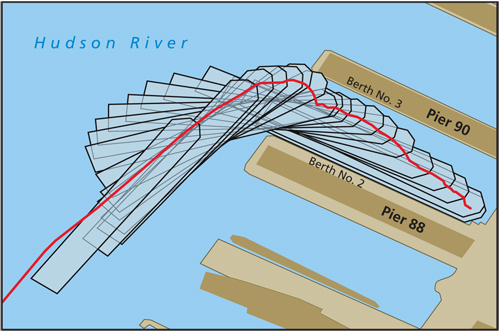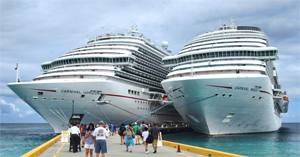Ineffective communication between the docking pilot and the master of a Carnival cruise ship was the primary cause of a 2018 pier strike in New York that caused $2.5 million in damage, according to federal investigators.
The National Transportation Safety Board (NTSB) also highlighted a perceived lack of engagement among bridge crew in the minutes before Carnival Horizon’s bow struck Pier 90 in Manhattan. The incident occurred just before dawn on Aug. 28, 2018, as the ship turned almost 90 degrees to dock starboard side-to at Pier 88. Shore-side facilities sustained most of the damage.
“As the ship continued to maneuver to the berth and rotated clockwise around the end of Pier 88, the bridge team and pilot progressively lost awareness of the vessel’s headway toward the end of Pier 90,” the NTSB said in its report.
“The pilot was focused on reducing the vessel’s rate of turn to starboard, while the ship was still moving forward toward Pier 90,” the report continued. “The closing distance went undetected or unchallenged by the bridge team until the ship was so close to the pier that no maneuver could have prevented the impact.”
The position of the third officer serving as a forward lookout contributed to the incident, the NTSB said. The officer alternated between starboard and port mooring platforms that did not offer a clear view of the bow. Carnival now positions a crewmember at the bow to gauge distances when docking at the Manhattan Cruise Terminal.
In a prepared statement, Carnival acknowledged the NTSB determination. “We have reviewed the NTSB report and will be using these findings as the basis for procedural recommendations and training,” company spokesman Vance Gulliksen said.
The incident occurred as the 1,062-foot, Panama-flagged Carnival Horizon returned to New York after an eight-day Caribbean cruise. There were 6,361 people on board: 4,922 passengers, 1,437 crew and two pilots, one from the Sandy Hook Pilots Association and a docking pilot from the Metro Pilots Association. The Sandy Hook pilot boarded the ship at the entrance to New York Harbor at 0318 and took the conn about 10 minutes later.
Carnival Horizon’s master hired a tugboat and docking pilot for the final maneuver into Pier 88, a voluntary decision influenced by the anticipated strong ebb current. The docking pilot boarded the ship at 0530 near Chelsea Pier 61 on the clear, calm morning. The Metro pilot and master worked together on at least two previous docking maneuvers at the Manhattan terminal.
 |
|
ECDIS data shows the ship’s track beginning at 0539 and ending at 0611. |
|
Pat Rossi illustration |
The master envisioned placing the 6,000-hp tugboat JRT Moran starboard roughly amidships to serve as a pivot point for the sharp turn, the NTSB said. Bridge recordings suggest the docking pilot and master were not in full agreement on the tug placement and did not fully resolve the issue. The pilot later placed the tug forward of the master’s preferred position.
The docking pilot, with 28 years of experience, took the conn from the Sandy Hook pilot at 0537. There were at least eight people on the bridge, including the two pilots, master, second officer, helmsman, lookout and staff captain charged with overseeing bridge operations. The third officer was positioned as a forward lookout on mooring platforms roughly 100 feet aft of the bow, which did not afford a clear view of the bow.
Two minutes later, at 0539, the master transferred control of the ship’s twin azimuth thrusters and three bow thrusters to the starboard bridge wing. During the next several minutes, the ship’s bow cleared Pier 88’s western edge with JRT Moran forward on the starboard side aft of the bow thrusters.
At 0548, Carnival Horizon was making 1 knot at a heading of 038 degrees with a 12-degree rate of turn to starboard. At that point, roughly 150 feet separated the bow from the southwest corner of Pier 90. A minute later the ship’s speed had increased to 1.2 knots, while the distance to the pier decreased to an estimated 50 feet with a 14-degree rate of turn.
“About 15 seconds later, the third officer reported they were ‘getting really close,’ to which the pilot immediately responded with a request to ‘back — go back,’” the report said. “At 0549, at a speed of 1.4 knots over ground ahead, on a heading of 054 degrees, the Carnival Horizon’s bow struck the second and third levels of Pier 90’s facility and parking garage.”
The report suggests the Metro pilot and ship master were so concerned the ebb tide would push the ship into Pier 88 that they did not properly monitor the approach toward Pier 90. The staff captain charged with overseeing the maneuver never raised concerns about the ship’s speed before the impact, the report said.
“Although Carnival’s navigation policy and task assignments require monitoring of the person conning the vessel, cross-checking of the ship’s position, and predicting track and headway, there was no evidence that any bridge team member probed or alerted the master and pilot of the headway of the vessel toward the corner of Pier 90,” the NTSB found.
The New Jersey Maritime Pilot and Docking Pilot Commission also investigated the incident. The commission found the Metro pilot did not conduct appropriate exchanges between the Sandy Hook pilot or the master prior to taking the conn. Attempts to reach the Metro Pilots Association for comment were not successful.

